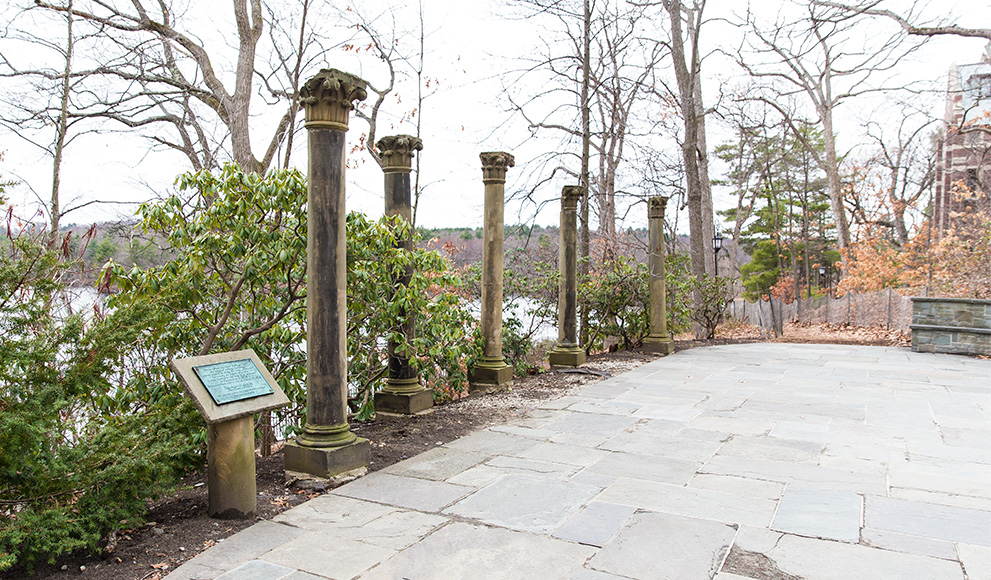55 Years After Their Graduation, the Class of 1917 Saved a Piece of Wellesley History

March 17th has great historical significance for Wellesley College: it is Founder’s Day—on this date in 1870, the College was chartered—and, on this same date 44 years later, the College was forever changed with the great fire. On March 17, 1914, College Hall—then the heart and soul of campus—burned to the ground. Today, five stone pillars that survived the destruction stand watch along the south side of Tower Court. Their presence is a testament to the unflagging devotion alumnae feel to the College.
A weathered plaque nearby tells part of the story: "These pillars are from College Hall the original college building which stretched along the brow of this hill for nearly an eighth of a mile. It was opened to the first 314 students on September 8, 1875. It burned from end to end on March 17, 1914."
Dedicated in 1972, the plaque and the restored pillars were a gift from the Class of 1917, "The last class to know the original Wellesley College."
The fire started about 4:30am, and within four hours the massive hall, which in those days housed 198 students, plus classrooms, various academic departments, the president’s office, a library and chapel, rare plants, and elaborate artwork, was reduced to ruins.
At 8:30am, students gathered in Houghton Memorial Chapel, where President Ellen Pendleton announced that spring break would begin immediately and the College would reopen on April 7. She also told them that “they—and not the building—were the college,” as Wellesley magazine has reported.
Eleanor Blair, Class of 1917, was a first-year at the time. She described the momentous events in a letter she wrote to her parents that day: "First, I never before so fully realized what Wellesley spirit meant. … College Hall is gone completely."
Most of the students lost practically everything, she explained, though a few managed to save a dress or a piece of jewelry. Despite that, "We’re all planning to earn money for a new building during vacation," she wrote. "You see this is a fine chance to show how much we love our alma mater, and we intend to do it, believe me!!!"
Eighteen months later, Tower Court opened on the site of the original building. The pillars from College Hall’s three colonnaded entrances ended up in a pile of rubble near a parking lot, where they languished for decades, according to the book Wellesley College 1875–1975: A Century of Women.
"Later, when the parking space was enlarged and the history of the columns all but forgotten, they were unceremoniously dumped in the margin of the Service Center on the golf course," the book states. There they were discovered by Eleanor Blair, alumnae president of the Class of 1917, who "had the imagination to see the value those broken pillars might have for all lovers of Wellesley if they could be reassembled and erected in an appropriate spot on the campus."
With the support of President Ruth M. Adams and the trustees of the College, and the financial backing of the Class of 1917, the fragments were reassembled. Five columns were restored and set on firm foundations, and in the spring of 1972, they were erected just below the spot where the columns of College Hall’s South Porch had stood when Wellesley’s first students looked through them to Lake Waban and the Hunnewell Gardens on the far shore.
Clellie Merchant '18, a history major and a resident assistant in Tower, understands the deep connections her forebears felt to Wellesley and its history.
"I give tours for the Office of Admission, and I always bring visitors up into Tower Courtyard by the back steps where the pillars stand," she said. "As we walk up the hill, I talk about College Hall and the fire. There are still times when I am moved, thinking about everything that we lost in 1914. Sometimes I need to reach out and touch one of the pillars. And when I do, the feeling of the cold stone reminds me of all that we did not lose, the intangible things that make Wellesley, Wellesley, and can never be taken away."
